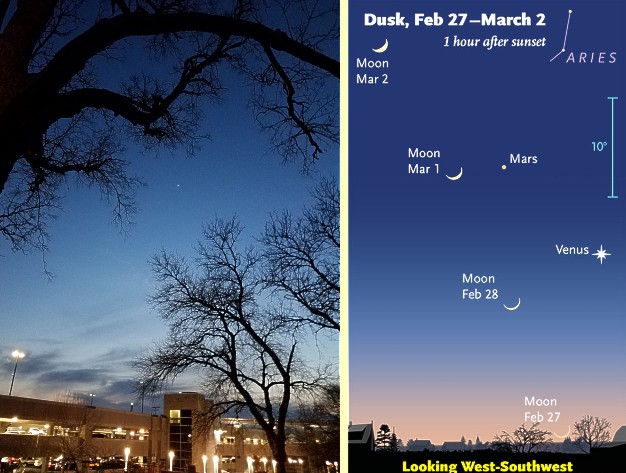Kansas Snapshots by Gloria Freeland - March 3, 2017
Standing here amazed
A recent announcement by the National Aeronautics and Space Administration caught my attention. The discovery of at
least seven Earth-sized planets orbiting the same star 40 light-years away boggles my mind.
Husband Art said amateur astronomers are doing a big part in the search for habitable planets. They don’t actually see
them, but instead, they point a telescope at a particular star and then attach a light sensor to it. The passage of a
planet in front of the star dims the light by a small amount. These changes are too slight to be seen by the human eye,
but by measuring the size and shape of the dip and how long it lasts, much can be determined about the planet’s size
and orbit.
While that’s interesting to me, I’m more into the beauty of the night sky. Our “German kids” Nadja and Tim also were
fascinated with it when they were with us. Since they grew up in the big city of Berlin, they had rarely experienced the
jet-black heaven we see in rural Kansas.
But despite enjoying the night sky, I’m not one of those people who sees constellations of bears and lions and other
figures in the pinpoints of light. I can find the Big Dipper and Little Dipper and that’s about it.
Still, the NASA announcement and a related recent experience caused me to do a bit of investigating. One evening last
month as I left work just after sunset, the silhouette of a towering tree against the still-blue sky made me stop in my
tracks. I snapped a few pictures with my smart phone. They were clearer than I expected and, when I looked closely, I was
surprised to see I had also captured a small bright object under the tree’s branches. Looking back at the sky, there it
was!
Later, as I traveled west toward home, the bright object again caught my attention.
An article on the Hutchinson, Kansas Cosmosphere website said that during February, all five of the visible planets -
Mercury, Venus, Mars, Jupiter and Saturn - would appear at the same time. It was not a star I had noticed, but the
planet Venus. It is the brightest planet because it is the closest to Earth and because its thick clouds reflect back
into space most of the sunlight that strikes it.
Earthsky.org had the following information about the planet:
Brilliant Venus is the "evening star." Okay, it’s not a star. It’s a planet. But people will call it the evening
star all the same. In these past weeks, many have noticed Venus and been amazed at its brilliance in the west after
sunset ...
Another website explained that Venus is also sometimes called the “morning star” because it can be seen in the southeast
early in the morning.
Art asked if I’ve seen the planets through a good telescope. I haven’t, but he has. When he was a youngster, a neighbor
had made several large telescopes, including grinding his own lenses and making the metal pieces. He said Jerry would stay up
all night looking at the heavens in his unheated observatory made from silo parts.
That wouldn’t be for me ... especially that unheated part.
But on one particularly clear night last week, I went outside several hours after sunset to observe the jet-black sky
peppered with twinkling stars and planets.
And it isn’t the first time. In October 2015, I spent more than an hour mesmerized by the progress of the “Supermoon” -
a phenomenon that caused a lot of “chatter” on social media. Because it was unusually close to the Earth at that time, it
appeared more than 10 percent larger and 30 percent brighter than normal and it had a red tint.
In August 2009, Art, daughter Katie and I spent several nights watching “shooting stars” - which were actually meteors
created by pieces of material ejected from comets. The ones we saw were part of the “Perseid meteor shower” produced by
particles left behind by the Swift-Tuttle comet, which orbits the sun once every 135 years.
Another comet - Hale-Bopp - appeared in late March and early April 1997, when I was in the Kansas Rehabilitation Hospital.
Art insisted that we see it, wheeling me outside in my wheelchair so I could get a good view. Its next appearance will be in
4397.
Fellow Kansan Brewster M. Higley was also a fan of the beautiful nighttime sky. In 1871, he was homesteading in
Smith County, Kansas, northwest of our home, when he penned the following words:
How often at night, when the heavens were bright,
With the light of the twinkling stars
Have I stood here amazed, and asked as I gazed,
If their glory exceed that of ours.
Those are, of course, words from the Kansas state song, “Home on the Range.”
I don't know if the beauty Higley saw in the night sky included a glimpse of the “Aurora Borealis” ... “ the Northern Lights” ...
or not. Art grew up in Wisconsin and has seen them many times. But I have yet to see them for they are visible less often in
Kansas. But I keep hoping to catch a glimpse when we’re at our cottage in northern Wisconsin in the late summer, but Art says
the best time is during the cool months of the year.
However, there is an event everyone can see and it is coming soon. According to earthsky.org, if the sky is clear and
there are no other obstructions, Venus will make an appearance as both the evening “star” and morning “star” for several days
beginning on or near March 20.
So if the sky cooperates and I don’t forget, you can be certain I’ll stand there amazed!
